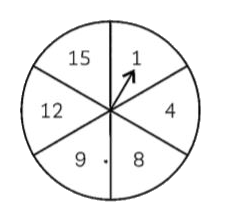Let a die be rolled n times. Let the probability of getting odd numbers seven times be equal to the probability of getting odd numbers twice is k215, then k is equal to
60
15
90
30
To solve the problem, we need to find the value of k such that the probability of getting odd numbers seven times when rolling a die n times is equal to the probability of getting odd numbers twice, expressed as k215.
1. Understanding the Problem:
- When rolling a die, the probability of getting an odd number (1, 3, or 5) is 36=12.
- The probability of getting an even number (2, 4, or 6) is also 36=12.
2. Setting Up the Probability Equations:
- The probability of getting odd numbers k times in n rolls is given by the binomial probability formula:
P(X=k)=(nk)(12)k(12)n−k=(nk)(12)n
- Therefore, the probability of getting odd numbers 7 times is:
P(X=7)=(n7)(12)n
- The probability of getting odd numbers 2 times is:
P(X=2)=(n2)(12)n
3. Setting the Probabilities Equal:
- According to the problem, we have:
P(X=7)=P(X=2)
- This leads to:
(n7)(12)n=(n2)(12)n
- We can cancel (12)n from both sides (assuming n≥7):
(n7)=(n2)
4. Using the Binomial Coefficient Identity:
- The identity (nk)=(nn−k) gives us:
(n7)=(nn−7)and(n2)=(nn−2)
- Therefore, we can set:
n−7=2orn−2=7
- Solving these gives:
- From n−7=2: n=9
- From n−2=7: n=9
5. Calculating k:
- Now we need to find k such that:
P(X=2)=k215
- We have:
P(X=2)=(n2)(12)n=(92)(12)9
- Calculate (92):
(92)=9×82×1=36
- Thus,
P(X=2)=36(12)9=36512=3629
- Setting this equal to k215:
3629=k215
- Cross-multiplying gives:
k=36×215−9=36×26=36×64=2304
Final Answer:
Thus, the value of k is 2304.
- When rolling a die, the probability of getting an odd number (1, 3, or 5) is 36=12.
- The probability of getting an even number (2, 4, or 6) is also 36=12.
- The probability of getting odd numbers k times in n rolls is given by the binomial probability formula:
P(X=k)=(nk)(12)k(12)n−k=(nk)(12)n
- Therefore, the probability of getting odd numbers 7 times is:
P(X=7)=(n7)(12)n
- The probability of getting odd numbers 2 times is:
P(X=2)=(n2)(12)n
- According to the problem, we have:
P(X=7)=P(X=2)
- This leads to:
(n7)(12)n=(n2)(12)n
- We can cancel (12)n from both sides (assuming n≥7):
(n7)=(n2)
- The identity (nk)=(nn−k) gives us:
(n7)=(nn−7)and(n2)=(nn−2)
- Therefore, we can set:
n−7=2orn−2=7
- Solving these gives:
- From n−7=2: n=9
- From n−2=7: n=9
- Now we need to find k such that:
P(X=2)=k215
- We have:
P(X=2)=(n2)(12)n=(92)(12)9
- Calculate (92):
(92)=9×82×1=36
- Thus,
P(X=2)=36(12)9=36512=3629
- Setting this equal to k215:
3629=k215
- Cross-multiplying gives:
k=36×215−9=36×26=36×64=2304
Thus, the value of k is 2304.
Topper's Solved these Questions
Similar Questions
Knowledge Check
A die is rolled. Find the probability of getting a cube number
A536B736C29D16An ordinary dice is rolled for a certain number of times. If the probability of getting an odd number 2 times is equal to the probability of getting an even number 3 times, then the probability of getting an odd number for odd number of times is :
A132B516C316D12
When a die is rolled twice. The probability of getting doublet is
View SolutionA die is rolled. Find the probability of getting a number greater than 6.
View SolutionA die is rolled n times. If the probability of getting odd number 2 times is equal to the probability of getting even number 3 times. Find the probability of getting odd number odd times
View SolutionA die is thrown once. What is the probability of getting an odd number?
View Solution
What is the probability of getting an odd number on the spinner?
View SolutionA die is rolled , find the probability of getting
a number less than 10 .
View Solution
